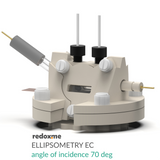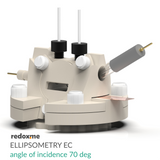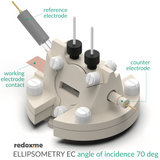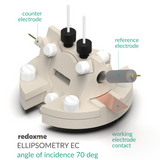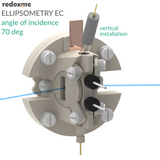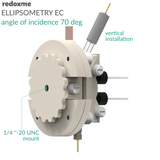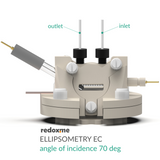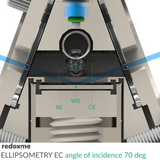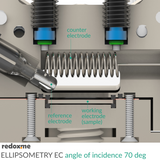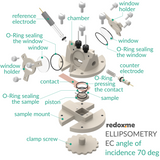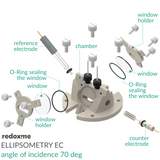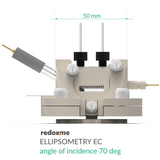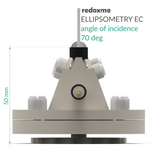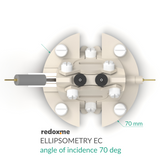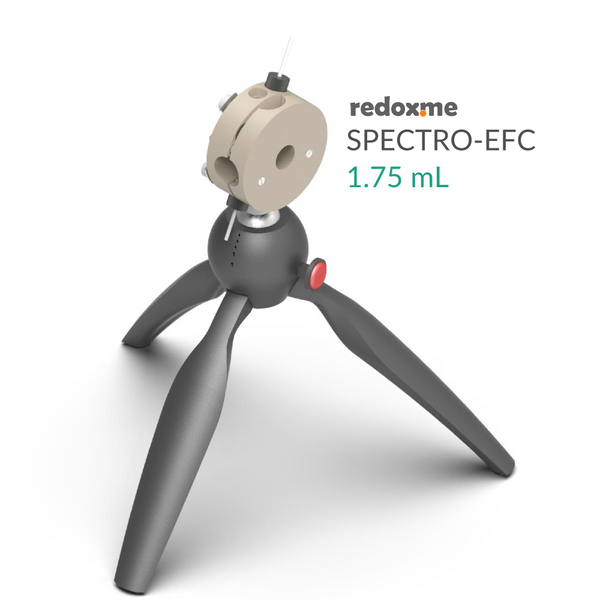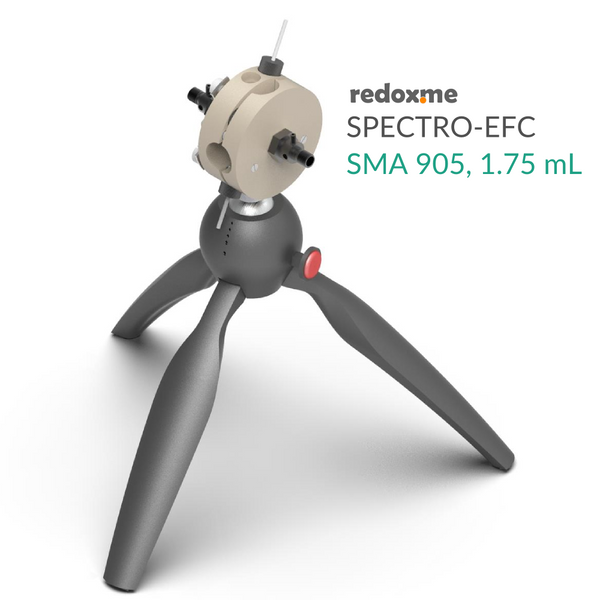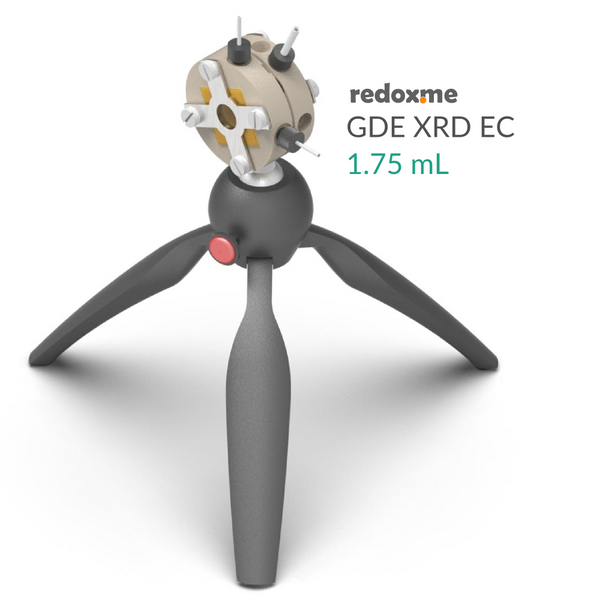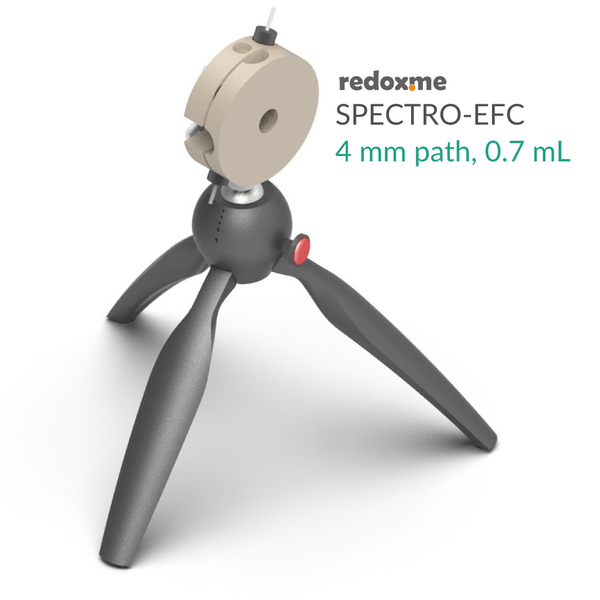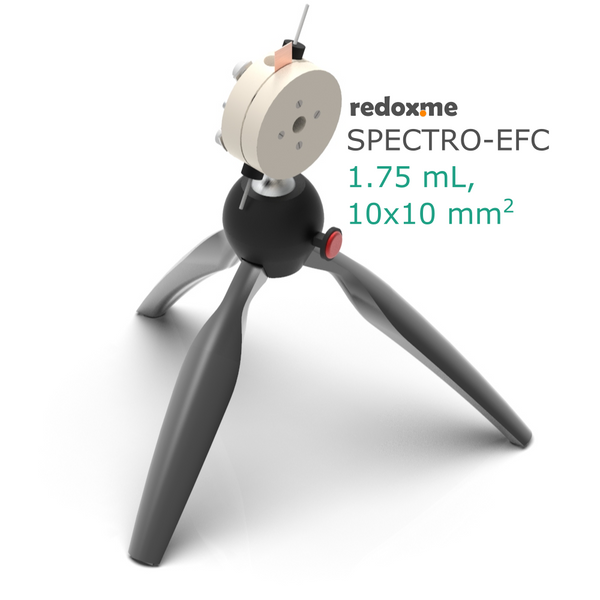Ellipsometry EC - Ellipsometry Electrochemical Cell, angle of incidence 70 deg
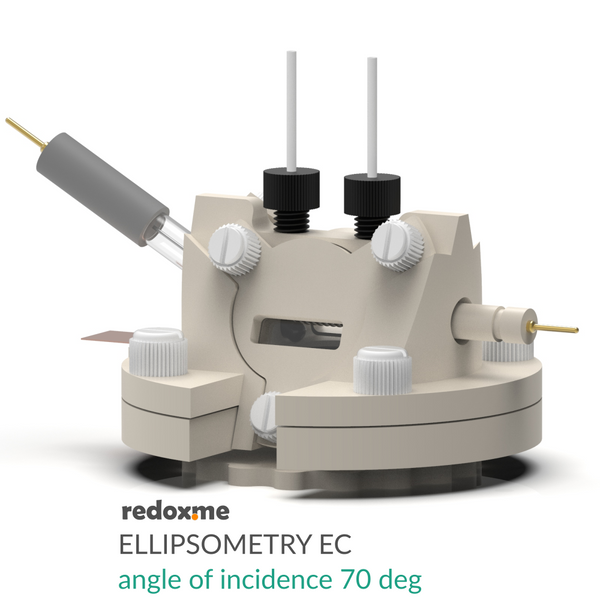
This cell combines two classical analytical techniques such as electrochemistry and reflective ellipsometry, to obtain in-situ change in phase and amplitude between the p-polarized and s-polarized components of the incident and reflected monochromatic light during the electrochemical process. This combination offers diagnostics of the nucleation and growth processes on a nanometer-thickness scale.
The cell consists mainly of two elements: (i) sample mount with copper foil serving as an electric contact to working electrode surface, and (ii) top casing in which reference and counter electrodes are installed together with electrolyte inlet and outlet. The sample consisting of a pure current collector or a thin film of electrochemically active material deposited on a rigid or flexible substrate (working electrode) is loaded from the bottom and sealed using clamp screw. The counter or/and reference electrodes are mounted in a top casing (either 2-, or 3-electrode setup). The helix counter electrode made of e.g. Platinum wire assures uniform distribution of the field lines along the path to working electrode. During an experiment, the beam is reflected from the sample surface through a pair of transparent windows installed perpendicularly to the incident light. The total optical path through the electrolyte is around 18 mm. Various window materials are available including JGS3 Quartz (default), Sapphire, CaF2 and Kapton. The Ellipsometry EC cell can be installed on a horizontally or vertically positioned stage of an ellipsometer. It may operate as both stagnant and flow cell. The cell elements are constructed with materials that are inert to the sample (glass and PEEK. It well fits aqueous (FKM/EPDM O-Rings) and organic solvent (FFKM O-Rings) electrolyte requirements. The construction is gas-tight and can be used when the removal and exclusion of contaminants such as oxygen and water is required by bubbling of an inert gas through the electrolyte (in an external reservoir).
Application note
Typical applications include real-time monitoring of a) an electrochemical deposition and growth of thin films (organic, inorganic and bio-materials); b) structural changes at the electrode/electrolyte interface for interfacial electrochemistry (e.g. electrocatalysis, corrosion, etching, Li/polymer electrolyte interphase, intercalation of ions). Various metals are suitable for this cell as auxiliary electrode including Platinum, Gold and Silver. For troubleshooting instruction see the redox.me blog post
Specification
nominal exposure area: 2.54 cm2 (18 mm dia.)
electrolyte volume: ~3 mL
optical path (without windows): ~26 mm
angle of incidence: 70 deg
electrode plug diameter: 6 mm
sample size: 25 mm x 25 mm
maximum sample thickness: 3 mm
Intrastat data
HS Code: 90275000
Country of Origin: Sweden
NET weight: 100g
Product includes
1 x sample mount
1 x clamp screw
1 x piston
1 x copper foil contact to WE
1 x chamber
2 x window holder
1 x alignment window holder
2 x quartz window – 25 mm dia. JGS3, 1 mm thick
1 x quartz window (alignment) – 5 mm dia. JGS3, 1 mm thick
1 x Ag/AgCl or non-aqueous Ag/Ag+ reference electrode
1 x Platinum wire counter electrode – 50HX15 0.6/250 mm
1 x set of O-rings
1 x set of Nylon screws
1 x plug
Related products
Metal Auxiliary Electrodes
Reference Electrodes
To familiarize yourself with operando-ellipsometry, we recommend the following great article:
Marta Cazorla Soult et al 2022 J. Electrochem. Soc. 169 040501, DOI 10.1149/1945-7111/ac5ceb
The above-mentioned authors greatly contributed to this product development.

